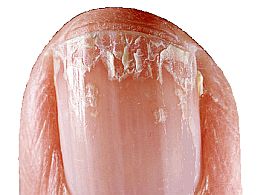Peeling Nails – Symptoms, Causes and Treatment of Peeling Fingernails

Nails peeling
Some people are born with healthy and strong fingernails, while others are born with soft, thin, brittle and/or peeling nails. In fact, research suggests that genetics determines the condition of someone’s nails. Peeling fingernails are normally not associated with a serious medical condition. The best way to stop fingernails from peeling is to protect and strengthen them. With knowledge and care, peeling nails can be successfully treated. This article examines the symptoms, causes and treatments associated with peeling nails.
Symptoms of Peeling Nails
There are not really any symptoms indicating when your nail is about to peel.
According to the Mayo Clinic and Medline Plus, nails that are yellow, opaque or white, indented and/or pitted, thin, weak, soft, curled, detached, blue, clubbed, ridged, streaked and/or distorted may require immediate treatment from a medical professional. In other words, it is best to contact a physician if there is a significant change in the appearance of the nails.
Causes of Peeling Nails
Although the exact cause of peeling nails varies, genetics and environmental factors appear to trigger this condition. According to the American Osteopathic College of Dermatology, the medical term for peeling nails is onychoschizia. This condition occurs more frequently in women than in men. It typically arises when nails experience a continuous cycle of water saturation followed by dryness. Some of the activities that can cause peeling nails include: scrubbing the bath tub and/or sinks, washing dishes, taking long baths or showers and swimming for long periods of time. Peeling fingernails tend to worsen during periods of dry heat and low humidity.
In addition, frequently wet and dry nails along with exposure to harsh dishwashing detergents and cleaning agents can lead to soft, brittle, thin and peeling nails. Moreover, nail polish removers that contain acetone can weaken nails and cause them to split and/or peel. It is important to note that in some rare cases, nutritional deficiencies (low levels of iron, vitamin C, B vitamins, etc.) can cause peeling fingernails. A balanced diet can stop nails from peeling by providing the nutrients that they need to stay healthy and strong.
Likewise, chronic autoimmune diseases, skin conditions and infections not only affect overall health, they can also thin and weaken nails causing them to peel. It is important to note that some women may experience peeling fingernails as a result of a hormonal disorder. When a hormonal imbalance is the cause, peeling nails may be associated with adrenal fatigue, diabetes and/or a thyroid disorder. Furthermore, aging may cause peeling nails in some individuals. In fact, as the body ages, it produces less oil and moisture, which can lead to weak and brittle nails that are prone to breakage, splitting and peeling.
Treatments for Peeling Nails
The most effective ways to stop peeling nails are to limit water exposure or protect them from water saturation. The American Osteopathic College of Dermatology recommends that individuals wear rubber gloves when cleaning the house (washing dishes and/or scrubbing the sinks and bath tubs). If the fingernails are exposed to a lot of water or cleaning agents, they should be moisturized with alpha hydroxy acids and/or lanolin-based lotions. In addition, it is best to keep all nails short and neat.
Trim irregular edges with a nail file a couple of times a week. If the nails are already weak, soft, brittle and/or peeling, avoid manicures until they are healthier and stronger. Mayo Clinic asserts that fingernail painting should only occur once a week, if that much. It also recommends using an acetone-free remover when taking off nail polish.
Other ways to stop peeling fingernails include: consuming biotin-rich foods. Biotin is a type of vitamin B. According to Dr. Herbert Luscombe, physician and professor of dermatology at Jefferson Medical College, biotin consumption is associated stronger, healthier and thicker nails. Foods like lentils, nuts and cauliflower can improve the condition of fingernails. In addition, Dr. Luscombe recommends taking 2.5 milligrams of biotin daily to stop peeling nails.
A healthy diet can also improve nail health. A balanced diet consisting of fatty fish, lean meats, beans and nuts can stop peeling fingernails. In addition, foods rich in iron, iodine, calcium and vitamins: A, B & C can also repair peeling nails. Drinking at least 64 oz. of water a day can strengthen nails and prevent them from peeling, breaking and and/or splitting.
According to Dr. Kristie Leong, family practice physician, it is important for an individual to moisturize his/her hands and nails, at least two times a day, preferable three times a day. She also suggests that the individual put vitamin E oil and/or jojoba oil on the damaged nails and/or nail beds daily. An effective way to treat severely dry and/or damaged nails is by moisturizing them and putting them in cotton gloves at night.
References:
American Osteopathic College of Dermatology. (2013). Brittle splitting nails. Retrieved from http://www.aocd.org/skin/dermatologic_diseases/brittle_splitting.html
Leong, L. (2009). Peeling fingernails: What can you do about them? Health Mad. Retrieved from http://healthmad.com/conditions-and-diseases/peeling-fingernails-what-can-you-do- about-them/
Luscombe, H. (2013). The doctor’s book of home remedies: Brittle nails. MotherNature.com. Retrieved from http://www.drvita.com/t-mothernature.aspx
Mayo Clinic. (2013). Fingernails: Do’s and don’ts for healthy nails. Retrieved from http://www.mayoclinic.com/health/nails/WO00020/NSECTIONGROUP=2
Mayo Clinic. (2013). How to keep nails healthy and strong. Retrieved from http://www.mayoclinic.com/health/adult-health/MY00382/DSECTION=nail-care
Medline Plus. (2013). Nail abnormalities. Retrieved from http://www.nlm.nih.gov/medlineplus/ency/article/003247.htm
-
Advertisement

 Facebook
Facebook  Twitter
Twitter  RSS
RSS







